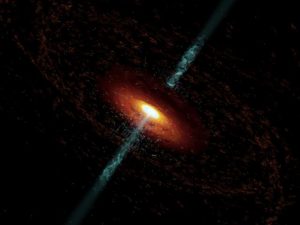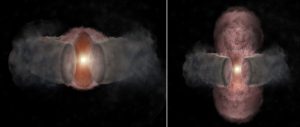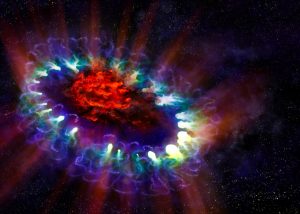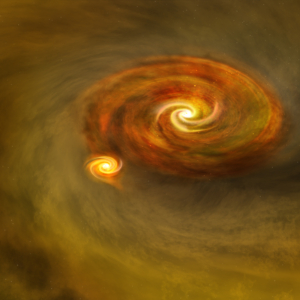Still image from an animation depicting the jets emitted by the black hole in galaxy 3C 120.


Unfolding Saga of Massive Star Formation
Artist’s conception of the development of W75N(B)-VLA-2.. At left, a hot wind from the young star expands nearly spherically, as seen in 1996. At right, as seen in 2014, the hot wind has been shaped by encountering a dusty, donut-shaped torus around the star and appears elongated.

Unraveling the Mystery of Nova Gamma Rays
The complex explosion and gas collisions in nova V959 Mon is illustrated here. In the first days of the nova explosion, dense, relatively slow-moving material is expelled along the binary star system’s equator (yellow material in left panel). Over the next several weeks, fast winds pick up and are blown off the binary, but they are funneled along the binary star system’s poles (blue material in central panel). The equatorial and polar material crashes together at their intersection, producing shocks and gamma-ray emission (red regions in central panel). Finally, at later times, the nova stops blowing a wind, and the material drifts off into space, the fireworks finished (right panel).

Dust Bowl of Supernova 1987A
This artist’s illustration of supernova 1987A reveals the cold, inner regions of the exploded star’s remnants (red) where tremendous amounts of dust were detected and imaged by ALMA. This inner region is contrasted with the outer shell (blue), where the energy from the supernova is colliding (green) with the envelope of gas ejected from the star prior to its powerful detonation.

Binary Star Formation
Binary star formation through disk fragmentation starts with a young star surrounded by a rotating disk of gas and dust. The disk fragments, with a second star forming within the disk, surrounded by its own disk. The two stars form an orbiting pair.

Starless Cloud Cores
This image shows the ALMA data overlaid on an artist’s impression background. The ALMA data show two main cores as imaged by emission from the molecular ion N2D+ (two nitrogen and one deuterium atom). The core on the right is particularly bright and rounded, suggesting it is self-gravitating and poised to form a massive, single star – a very rare occurrence in star formation. The other core appears more distorted and fragmented, potentially leading to the formation of multiple lower-mass stars. This fragmentation is a normal process in star-forming clouds.





